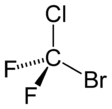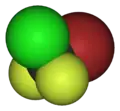Bromochlorodifluoromethane
Bromochlorodifluoromethane (BCF), also referred to by the code numbers Halon 1211 and Freon 12B1, is a haloalkane with the chemical formula CF2ClBr. It is used for fire suppression, especially for expensive equipment or items that could be damaged by the residue from other types of extinguishers.[1] It is stored as a liquid under pressure and vaporizes when discharged to suppress fires.[2] The use of halons, including Halon 1211, has decreased over time due to their adverse impact on the ozone layer. Alternatives have been developed to mitigate environmental concerns while still providing effective fire suppression capabilities.
| |||
| Names | |||
|---|---|---|---|
| Preferred IUPAC name
Bromo(chloro)difluoromethane | |||
| Other names
Bromochlorodifluoromethane Halon 1211 Halon 1211 BCF BCF Freon 12B1 | |||
| Identifiers | |||
3D model (JSmol) |
|||
| ChEBI | |||
| ChemSpider | |||
| ECHA InfoCard | 100.005.944 | ||
| EC Number |
| ||
PubChem CID |
|||
| UNII | |||
CompTox Dashboard (EPA) |
|||
| |||
| |||
| Properties | |||
| CBrClF2 | |||
| Molar mass | 165.36 g/mol | ||
| Appearance | Colorless gas | ||
| Density | 7,1362 kg·m−3 (15 °C, 1 bar) | ||
| Melting point | −159.5 °C (−255.1 °F; 113.6 K) | ||
| Boiling point | −3.7 °C (25.3 °F; 269.4 K) | ||
Except where otherwise noted, data are given for materials in their standard state (at 25 °C [77 °F], 100 kPa).
Infobox references | |||
Use as a fire extinguishing agent
Brominated haloalkanes were first used during World War II in fire extinguishers for aircraft and tanks. BCF was introduced as an effective gaseous fire suppression agent in the mid-1960s for use around highly valuable materials in places such as museums, mainframe rooms, and telecommunication switching centers. BCFs were also widely used in the maritime industries in the engine rooms of ships and also in the transport industry in vehicles. Its efficiency as a fire extinguishing agent has also led it to be the predominant choice of fire extinguishing agent on commercial aircraft and is typically found in cylindrical hand-held canisters. Its advantages as a fire extinguishing agent are that it has lower toxicity than chemicals such as carbon tetrachloride and that since it is a covalently bonded compound, it does not form conductive ions, therefore being usable on electrical equipment.
BCF is an excellent fire extinguishing agent, as it is a streaming agent with low toxicity, a low pressure, liquefied gas, and effective on all common types of fires, A, B, and C.[3][4] It is mainly used in portable and wheeled extinguishers, and small spot protection units for aviation and marine engine applications, and was never widely used in fixed systems like Halon 1301 was.
BCF has fairly low toxicity. The lethal concentration for 15 minute exposure is about 32%.[5]
Synthesis
BCF is commercially synthesized in a two-step process from chloroform. Chloroform is fluorinated with hydrogen fluoride. The resulting chlorodifluoromethane is then reacted with elemental bromine at 400-600 °C, with reaction time limited to about 3 seconds. The overall yield is over 90%.[5]
Regulation
The production of BCF and similar chlorofluorocarbons has been banned in most countries since January 1, 1994 as part of the Montreal Protocol on ozone depleting substances. Halon 1211 is also a potent greenhouse gas with a 100-year global warming potential 2,070 times that of carbon dioxide and an atmospheric lifetime of 16.0 years.[6]
Recycling of Halon 1211 allows it to remain in use,[7][8] although parts availability is limited to a few manufacturers and can be an issue. Halon 1211 is still widely used in the United States, despite its high cost, with the US military being the biggest user. Europe and Australia have banned its use for all but "critical applications" such as aviation, military, and police use. The manufacture of UL Listed halon 1211 extinguishers was supposed to cease on October, 2009. The future listing is still in discussion. Halotron I, the replacement extinguishing agent, requires a larger volume to get the same ratings as 1211.
Gallery
 H-1211 measured by the Advanced Global Atmospheric Gases Experiment (AGAGE) in the lower atmosphere (troposphere) at stations around the world. Abundances are given as pollution free monthly mean mole fractions in parts-per-trillion.
H-1211 measured by the Advanced Global Atmospheric Gases Experiment (AGAGE) in the lower atmosphere (troposphere) at stations around the world. Abundances are given as pollution free monthly mean mole fractions in parts-per-trillion. Halon 1211 Fire Extinguisher, USA, early 1990s.
Halon 1211 Fire Extinguisher, USA, early 1990s. A portable aviation Halon 1211 fire extinguisher, USA, 2015.
A portable aviation Halon 1211 fire extinguisher, USA, 2015.
References
- Dagani, M. J.; Barda, H. J.; Benya, T. J.; Sanders, D. C. "Bromine Compounds". Ullmann's Encyclopedia of Industrial Chemistry. Weinheim: Wiley-VCH. doi:10.1002/14356007.a04_405.
- "The Halon Advantage".
- Tryon, George H.; et al. (others) (1969). Fire Protection Handbook Thirteenth Edition 1969. Boston Massachusetts: National Fire Protection Association. LCCN 62-12655.
- Cote, Arthur E.; et al. (others) (1997). Fire Protection Handbook Eighteenth Edition. Quincy, Massachusetts: National Fire Protection Association. ISBN 0-87765-377-1.
- Rozen, Shlomo; Hagooly, Aviv (2005). Bromochlorodifluoromethane. doi:10.1002/047084289X.rn00562. ISBN 0471936235.
{{cite book}}:|work=ignored (help) - Hodnebrog, Øivind; Åmås, Borgar; Fuglestvedt, Jan; Marston, George; Myhre, Gunnar; Nielsen, Claus Jørgen; Sandstad, Marit; Shine, Keith P.; Wallington, Tim J. (July 9, 2020). "Updated Global Warming Potentials and Radiative Efficiencies of Halocarbons and Other Weak Atmospheric Absorbers". Reviews of Geophysics. 58 (3).
- "Basic Facts about Halon". H3R Clean Agents. Archived from the original on 2012-01-04.
- "Recycling Halon". H3R Clean Agents. Archived from the original on 2020-08-09.
External links
- International Chemical Safety Card 0635
- Institut national de recherche et de sécurité (1988). "Bromochlorodifluorométhane." Fiche toxicologique n° 165. Paris:INRS. (in French)
- Aviation fire extinguisher requirements

